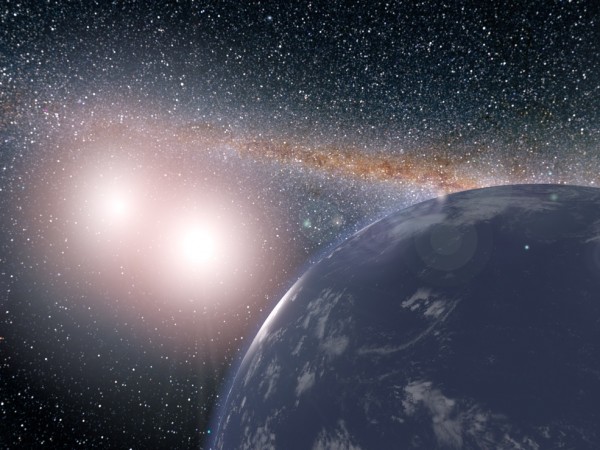By Ana Verayo, | April 13, 2017

This artist's concept shows a hypothetical planet covered in water around the binary star system of Kepler-35A and B. (NASA/JPL-Caltech)
Scientists have discovered planets similar to "Tatooine" in Star Wars, which is the home of Luke Skywalker, a desert world orbiting two suns. In a new study, scientists say that real-life Tatooine planets, which are also Earth-like, could potentially host life.
A new model was created based on a binary star system called Kepler 35. Scientists replaced Kepler 35b, which is an exoplanet eight times larger than Earth, with an Earth-sized planet. In this new study, scientists were able to predict the orbital path of two stars orbiting Kepler 35a and b, which can significantly affect the composition and formation of a rocky planet's atmosphere.
Like Us on Facebook
"Our new findings is driven by the search for potentially habitable planets and this endeavor certainly requires a lot of effort, which makes this system a good place to look for. This means that it is worth targeting double star systems to present an Earth-like planet's habitability," Siegfried Eggl from NASA's Jet Propulsion Laboratory and Caltech said.
Scientists consider an exoplanet potentially habitable when liquid water is present on its surface. When planets are too close or too far from its star, water will disappear fast or not form at all, leaving it frozen. However, when an exoplanet is in the middle of its star system, the right conditions for life will flourish.
For double star systems, the prospect of habitability is more complex since more cosmic objects are in motion, orbiting the two stars. When two stars are orbiting each other, the planet's orbit will not become circular, resulting in a wobbling orbit due to extreme and powerful gravitational forces from the stars.
Researchers suggest that a rocky, Earth-like planet orbiting in the outer edge of Kepler 35 in the habitable zone can only produce not enough water vapor. This also means that this world will experience extreme temperature shifts every year, as global temperature averages can shift to as much as 3.6 degrees.
"This is similar to arid climates on Earth such as deserts, where these places experience extreme temperatures from day to night. However, the only major difference here is the amount of water present in the air," Eggl explained.
On the other hand, a rocky, Earth-like planet within the inside edge of the habitable zone of Kepler 35 can produce more water vapor. This also means a more stable atmosphere and consistent shifts in temperature. The model also reveals that this exoplanet could produce a few clouds and clear skies for a fantastic view of a double sunset.
This study was published in the journal Nature Communications.
-
Use of Coronavirus Pandemic Drones Raises Privacy Concerns: Drones Spread Fear, Local Officials Say

-
Coronavirus Hampers The Delivery Of Lockheed Martin F-35 Stealth Fighters For 2020

-
Instagram Speeds Up Plans to Add Account Memorialization Feature Due to COVID-19 Deaths

-
NASA: Perseverance Plans to Bring 'Mars Rock' to Earth in 2031

-
600 Dead And 3,000 In The Hospital as Iranians Believed Drinking High-Concentrations of Alcohol Can Cure The Coronavirus

-
600 Dead And 3,000 In The Hospital as Iranians Believed Drinking High-Concentrations of Alcohol Can Cure The Coronavirus

-
COVID-19: Doctors, Nurses Use Virtual Reality to Learn New Skills in Treating Coronavirus Patients







